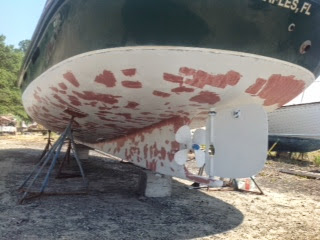At the Olympia Rendezvous I asked Tommy Chen why the starboard pilothouse windows only partially opened. After Tommy put the back of his hand on my forehead to check my temperature, did I find out that this issue was specific to
Brave Duck (maybe), and that probably some foreign item was down in the window well. Sure enough, with my eyeball pressed tightly against the closed window pane, I could see something down in the well, and the fishing expedition began.
A Plexiglas sign was wedged in the bottom of the well. I tried with no luck to dislodge it with a 3' steel rod. A better tool turned out to be a flyswatter with some sticky-side-out duct tape attached to it. With this contraption, and after many tries, I finally was able to slowly raise the obstruction out. It was a broker's "For Sale" sign that apparently had been taped to the inside of the window, fallen off, and remained there since Tom Black (the original owner) sold the boat. I don't know when Tom Black actually sold, what was then,
Josh Anne, but let's say it was maybe 1990. That means that for 24 years both the previous owner and I assumed that the starboard window only opened half way.
An interesting aside, since as the third owners we bought the boat here in the SF Bay area, this has to be the sign that the second owners saw when they bought the
Josh Anne in Seattle.
And that, as they say, is the rest of the story...
Phil






